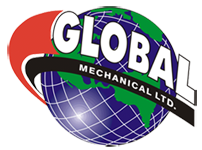Navigating Fire Bylaws & HVAC Upgradeswith Global Mechanical
Condo Board Chronicles of Compliance and Cost-Effective Solutions

“Wow!” was all the directors could say when their condo Property Manager broke the news that they had been hit with a $5,000 penalty for non-compliance by the City of Winnipeg Property Planning and Development regarding fire bylaw 4304. Surprise was quickly followed by confusion. What were they guilty of? No information accompanied the notice other than to pay upfront and then appeal to the city!
Condominiums Boards are responsible for following city regulations and bylaws. Given the enforcement of this fire bylaw had been dormant for over 20 years, it caught over 100 property owners off-guard. What has led to recent inspections is the City of Winnipeg’s review of unclosed permits. Failing to close a permit can lead to problems on future renovations, inspections and the selling of the property. Some view this as an unjustified “cash grab” that preys upon the citizenry.
To satisfy the City, the corporation needed to install 21 fire dampers on the exhaust vents in the parkade. Until now this building had always passed regular inspections from the Fire Department and the board had never been informed of a problem or a bylaw violation.
Fire dampers serve as a barrier to prevent a fire from travelling through the ventilation system and into the units. Simply put, a fire damper is a metal box with a heat-sensitive link that melts and releases a spring-loaded flap or damper to close the vent; essentially like a mousetrap. What complicates the installation, is accessibility issues and existing conduits for electrical and plumbing.
The directors decided to appeal the penalty but were refused a hearing when the City stated that it has the “right to issue fines”. Unsatisfied with the response, the directors have contested the decision.
Despite the dispute, the work needed to get underway and the Board needed to obtain quotes and contractors for the job. They quickly realized many Heating, Ventilation and Air Conditioning (HVAC) businesses only do portions of the job and farm out the rest. Subcontracting at this level meant costs would rise at each change of hands and the Board would be responsible for permits, and performing their due diligence in the hiring certified technicians and ensuring appropriate quality control. Though they had their own blueprints, they were required to provide new ones based on the latest engineering standards which could cost as much as $15,000. The HVAC quotes varied from $55,000 to over $100,000.
After extensive research, they found a company that would take care of all aspects of the fire damper installation using their own staff. This meant affordable recommendations, permits, qualified technicians, a reasonable time-line and a plan for future reporting and testing. The big benefit, was communicating with one main point of contact.
Once the contract was outlined and signed, the next step was to set up the logistics of the work schedule and staging area for on-site shop work. The Resident Manager needed to ensure contractor access, notify residents and coordinate the removal of vehicles. The project was completed successfully, on-time and to the satisfaction closure of our M1 permit by the City inspector.
The trades-people on-site conducted themselves professionally and answered any questions from the directors and owners.
Moving forward, routine maintenance becomes an ongoing responsibility for the property owner, and is handled by qualified technicians. Damage to the damper fuse link by an inexperienced vent cleaner, can result in costly repairs to maintain bylaw compliance. (See of CCI Condominium News and Views, Summer 2017 issue).
Tips when engaging in a large HVAC project:
Take the time to be aware of what the project entails and ask detailed questions.
Make sure the contractor takes the time to fully explain all aspects of the project with a demo of how the dampers and related equipment function and the fire-barrier issues involved. A number of design solutions should be considered along with site visits, and detailed communication before settling on final contract specifications.

Consider the following when developing a contract:
Work Specific:
- The final accepted estimate becomes part of the contract and properly signed by Board or the Property Manager.
- Define expected deadlines and performance expectations.
- All materials pertaining to the job will be supplied by the contractor.
- The contract comes into effect on receipt of a Purchase Order or written authorization to proceed and ends when warranty is complete unless mutually agreed.
- All shop drawings and delivery schedules will be provided by the contractor in line with an approved permit to begin work.
- Clauses relating to delays, change orders to scope of work, and warranties.
- Final product finishing and site cleanup.
General Contractor Requirements:
- Maintain Public and Property insurance for the work and proof of insurance documents will be made available upon request.
- Comply with requirements of the Workers Compensation Act for all employees and subcontractors, including protocols around handling dangerous materials such as asbestos.
- Comply with all applicable Provincial, Municipal and Federal laws, rules and regulations.
- Secure and properly close all permits as described in the documents and notify the Condominium management.
Payment:
- Determine final total including, contract price, GST, PST.
- Decide in advance where are the funds to come from – Reserve, Loan, Special Assessment.
- Consider any Progress Phasing based upon payment as steps are concluded.
- Confirm the holdback based upon final approval and satisfactory completion of the project.
We hope the experiences shared by this condo Board are helpful and provide some practical insights into how you may successfully approach any HVAC project. Remember, don’t be afraid to ask questions - it’s your money!
-------------------------------------
Jim Stuparyk, WCC 97
Teresa Shepit
Published in Canadian Condominium Institute, Manitoba Chapter, Summer 2018
